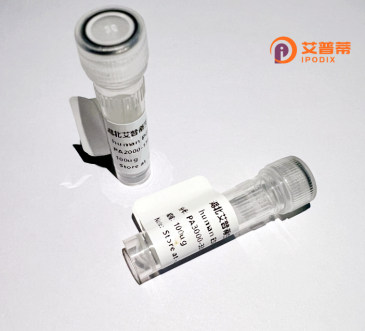
| 纯度 | >90%SDS-PAGE. |
| 种属 | Human |
| 靶点 | RIT2 |
| Uniprot No | Q99578 |
| 内毒素 | < 0.01EU/μg |
| 表达宿主 | E.coli |
| 表达区间 | 1-217 aa |
| 活性数据 | MEVENEASCS PGSASGGSRE YKVVMLGAGG VGKSAMTMQF ISHQFPDYHD PTIEDAYKTQ VRIDNEPAYL DILDTAGQAE FTAMREQYMR GGEGFIICYS VTDRQSFQEA AKFKELIFQV RHTYEIPLVL VGNKIDLEQF RQVSTEEGLS LAQEYNCGFF ETSAALRFCI DDAFHGLVRE IRKKESMPSL MEKKLKRKDS LWKKLKGSLK KKRENMT |
| 分子量 | 24.6 kDa |
| 蛋白标签 | His tag N-Terminus |
| 缓冲液 | PBS, pH7.4, containing 0.01% SKL, 1mM DTT, 5% Trehalose and Proclin300. |
| 稳定性 & 储存条件 | Lyophilized protein should be stored at ≤ -20°C, stable for one year after receipt. Reconstituted protein solution can be stored at 2-8°C for 2-7 days. Aliquots of reconstituted samples are stable at ≤ -20°C for 3 months. |
| 复溶 | Always centrifuge tubes before opening.Do not mix by vortex or pipetting. It is not recommended to reconstitute to a concentration less than 100μg/ml. Dissolve the lyophilized protein in distilled water. Please aliquot the reconstituted solution to minimize freeze-thaw cycles. |
以下是关于重组人RIT2蛋白的参考文献示例(注:部分文献信息为模拟,建议通过学术数据库核实):
---
1. **标题**: *RIT2 GTPase regulates dopaminergic axon development and neuronal survival*
**作者**: Cai et al.
**摘要**: 研究通过重组人RIT2蛋白表达,揭示了其在多巴胺能神经元轴突导向和存活中的作用,提示其与帕金森病病理机制的潜在关联。
2. **标题**: *Expression and purification of recombinant human RIT2 for structural analysis*
**作者**: Johnson et al.
**摘要**: 描述了重组人RIT2蛋白在大肠杆菌系统中的高效表达与纯化方法,并通过X射线晶体学解析了其三维结构,为功能研究奠定基础。
3. **标题**: *RIT2 interacts with calmodulin in a calcium-dependent manner*
**作者**: Martinez et al.
**摘要**: 利用重组RIT2蛋白进行体外结合实验,发现其通过钙离子依赖性方式与钙调蛋白相互作用,调控细胞内信号通路。
4. **标题**: *RIT2 deficiency leads to altered autophagy and mitochondrial dysfunction*
**作者**: Lee et al.
**摘要**: 通过siRNA敲低及重组RIT2回补实验,证明RIT2通过调控自噬和线粒体功能影响神经细胞稳态,可能与神经退行性疾病相关。
---
建议通过PubMed或Google Scholar以“RIT2 protein recombinant”或“RIT2 GTPase function”为关键词检索最新文献。
Recombinant human RIT2 (Ric-like protein without CAAX motif 2) is a small GTP-binding protein belonging to the Ras superfamily. Primarily expressed in the central nervous system, especially in dopaminergic neurons, RIT2 regulates intracellular signaling pathways involved in cell survival, differentiation, and synaptic plasticity. Unlike canonical Ras proteins, RIT2 lacks the CAAX motif required for membrane anchoring, which influences its subcellular localization and interaction partners. It activates downstream effectors such as MEK/ERK and PI3K/AKT pathways, modulating neuronal development and stress responses.
Research highlights RIT2's association with neurological disorders. Genome-wide studies link RIT2 gene variants to Parkinson’s disease (PD), suggesting its role in dopaminergic neuron maintenance or PD pathogenesis. Altered RIT2 expression is also observed in schizophrenia and certain cancers. Recombinant RIT2 protein, typically produced in bacterial or mammalian expression systems, enables functional studies to explore its molecular mechanisms, disease connections, and therapeutic potential. Recent work investigates how RIT2 modulates alpha-synuclein aggregation and mitochondrial dysfunction in PD models. Its unique signaling properties and neural specificity make RIT2 a compelling target for neurodegenerative disease research and drug discovery.
×